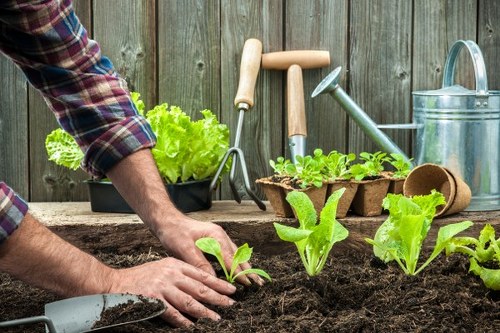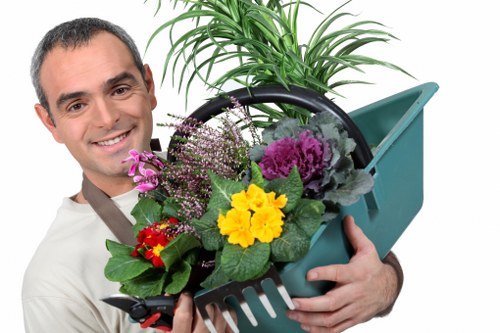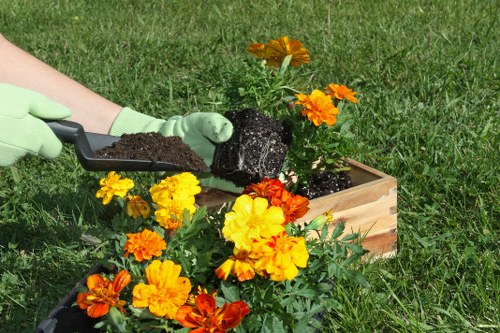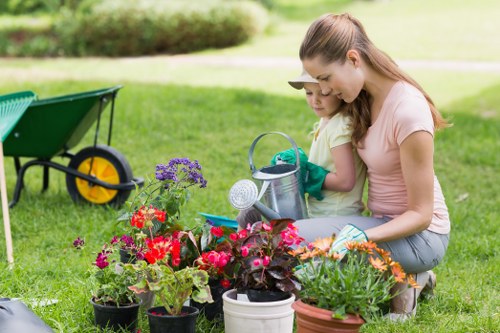Landscaping in Gardening Services: Transforming Outdoor Spaces

Landscaping plays a crucial role in the realm of gardening services, offering homeowners and businesses alike the opportunity to enhance their outdoor spaces. Whether it's for aesthetic appeal, functional use, or environmental benefits, professional landscaping can make a significant difference.
In this comprehensive guide, we'll delve into the various aspects of landscaping within gardening services. From design principles to maintenance tips, you'll gain valuable insights into creating and sustaining beautiful outdoor environments.
Understanding the fundamentals of landscaping is essential for anyone looking to improve their property's curb appeal or create a serene backyard retreat. Let's explore the key components that make landscaping an integral part of gardening services.

The Importance of Professional Landscaping
Professional landscaping goes beyond mere plant selection. It involves strategic planning, design, and execution to create cohesive and sustainable outdoor spaces. Here are some reasons why investing in professional landscaping is beneficial:
- Aesthetic Enhancement: Professionally designed landscapes significantly improve the visual appeal of any property.
- Increased Property Value: Quality landscaping can boost your property's market value.
- Environmental Benefits: Proper landscaping can improve air quality, reduce erosion, and support local wildlife.
- Functional Spaces: Create areas for relaxation, entertainment, or gardening, tailored to your specific needs.
By leveraging the expertise of landscaping professionals, you ensure that your outdoor spaces are not only beautiful but also functional and sustainable.

Key Elements of Landscaping
1. Design and Planning
Effective landscaping begins with thoughtful design and planning. This involves assessing the existing site conditions, understanding the client's preferences, and creating a layout that harmonizes with the natural surroundings.
Site Analysis
Conducting a thorough site analysis helps identify factors such as soil quality, sunlight exposure, drainage patterns, and existing vegetation. This information is crucial for making informed design decisions.
Creating a Master Plan
A master plan outlines the overall vision for the landscape, including the placement of plants, hardscapes, water features, and lighting. It serves as a roadmap for the implementation phase.

Choosing the Right Plants
Selecting appropriate plant species is fundamental to successful landscaping. Considerations include climate, soil type, maintenance requirements, and the desired aesthetic.
- Drought-Tolerant Plants: Ideal for regions with limited water resources.
- Native Plants: Support local ecosystems and require less maintenance.
- Seasonal Blooms: Provide year-round interest with varying colors and textures.
- Evergreen Varieties: Maintain structure and greenery throughout the year.
By selecting the right plants, you ensure a resilient and vibrant landscape that thrives with minimal upkeep.

Hardscaping: Enhancing Functionality
Hardscaping refers to the non-living elements of landscaping, such as pathways, patios, walls, and water features. These components add structure and functionality to outdoor spaces.
Pathways and Walkways
Well-designed pathways guide visitors through the landscape, connecting different areas and enhancing accessibility. Materials like stone, gravel, or pavers can be chosen based on the desired look and durability.
Patios and Outdoor Living Areas
Patios serve as focal points for outdoor gatherings, providing a space for dining, relaxation, and entertainment. Incorporating features like seating, fire pits, and lighting can elevate the usability of these areas.
Water Features
Incorporating water elements such as fountains, ponds, or waterfalls adds a soothing ambiance and attracts wildlife. They can also serve as eye-catching focal points within the landscape.

Maintenance and Sustainability
Maintaining a landscaped garden requires ongoing care to ensure its longevity and health. Sustainable practices not only preserve the beauty of the landscape but also promote environmental responsibility.
- Regular Pruning: Keeps plants healthy and encourages growth.
- Weed Control: Prevents unwanted plants from overtaking the desired vegetation.
- Soil Health: Amendments and mulching improve soil fertility and moisture retention.
- Irrigation Management: Efficient watering systems conserve water and support plant health.
Adopting sustainable maintenance practices ensures that your landscape remains vibrant and eco-friendly for years to come.

Seasonal Landscaping Tips
Different seasons bring unique challenges and opportunities for landscaping. Adapting your gardening practices to each season can enhance the overall health and beauty of your outdoor spaces.
Spring
- Plant new flowers and shrubs.
- Clean and prepare garden beds.
- Start a fertilization schedule.
Summer
- Ensure adequate watering to prevent drought stress.
- Mulch to retain soil moisture.
- Prune summer-blooming plants as needed.
Autumn
Autumn is ideal for planting trees and perennials. It's also a time to clean up fallen leaves and prepare plants for the colder months.
Winter
Protect sensitive plants from frost and snow. Plan for the upcoming growing season by reviewing and updating your landscaping design.

Integrating Technology in Landscaping
Modern landscaping harnesses technology to enhance design, maintenance, and sustainability. From smart irrigation systems to landscape design software, technology plays a pivotal role in contemporary gardening services.
Smart Irrigation Systems
These systems use sensors and weather data to optimize watering schedules, conserving water and ensuring plants receive the right amount of moisture.
Landscape Design Software
Design software allows landscapers to create detailed plans, visualize different elements, and make adjustments before implementation, ensuring precision and client satisfaction.
Automated Maintenance Tools
Robotic mowers, automated fertilization systems, and other tools streamline maintenance tasks, saving time and labor.

Choosing the Right Landscaping Service
Selecting a reputable landscaping service is crucial for achieving the desired results. Consider the following factors when making your choice:
- Experience and Expertise: Look for companies with a proven track record in landscaping.
- Portfolio: Review previous projects to assess their style and quality.
- Client Reviews: Testimonials and reviews provide insight into customer satisfaction.
- Services Offered: Ensure the company offers the specific services you need.
- Cost and Value: Balance your budget with the quality and scope of services provided.
By carefully evaluating potential landscaping services, you can partner with professionals who align with your vision and requirements.

Enhancing Curb Appeal
Curb appeal is the first impression your property makes. Strategic landscaping can significantly enhance the exterior appearance, making your home or business more inviting.
Front Yard Landscaping
A well-maintained front yard with vibrant plants, clean pathways, and attractive hardscapes sets a positive tone. Consider adding elements like flowering plants, ornamental trees, and stylish lighting.
Driveway and Walkway Design
Incorporate materials and designs that complement your property's architecture. Curved pathways, patterned pavers, and bordered gardens add visual interest.
Entrance Features
Highlight your entrance with features such as archways, trellises, or benches. These additions create a welcoming atmosphere.

Creating Functional Outdoor Spaces
Beyond aesthetics, landscaping can create functional outdoor areas tailored to your lifestyle. Whether it's a space for entertaining, gardening, or relaxation, proper design is key.
Outdoor Living Areas
Designate areas for outdoor dining, lounging, or cooking. Incorporate comfortable seating, weather-resistant furniture, and appropriate shading.
Gardening Zones
Create dedicated spaces for vegetable gardens, herb patches, or ornamental plants. Organized gardening zones simplify maintenance and enhance productivity.
Recreational Spaces
Include features like playgrounds, sports courts, or water play areas to cater to family activities and recreation.

Sustainable Landscaping Practices
Sustainability is increasingly important in landscaping, aiming to minimize environmental impact while maximizing resource efficiency and ecological benefits.
- Rainwater Harvesting: Collect and utilize rainwater for irrigation.
- Native Plant Selection: Use plants adapted to the local climate, reducing water and maintenance needs.
- Compost and Mulch: Improve soil health and reduce waste through composting and mulching.
- Energy-Efficient Lighting: Implement solar-powered or LED lighting to conserve energy.
Adopting sustainable practices not only benefits the environment but also reduces long-term maintenance costs.

The Role of Lighting in Landscaping
Lighting is a vital component of landscaping, enhancing both safety and aesthetics during nighttime hours. Thoughtful lighting design can highlight architectural features, illuminate pathways, and create ambiance.
Pathway Lighting
Illuminate walkways to ensure safety and guide visitors through the landscape. Options include embedded lights, stake lights, or lanterns.
Accent Lighting
Highlight specific features such as trees, sculptures, or water elements with focused lighting.
Ambient Lighting
Create a warm and inviting atmosphere with soft, general lighting around outdoor living areas.

Integrating Hardscapes and Softscapes
The harmonious integration of hardscapes (non-living elements) and softscapes (living elements) is essential for a balanced and visually appealing landscape.
Balancing Elements
Ensure that hardscapes and softscapes complement each other in terms of style, scale, and color. This balance creates coherence and prevents one element from overpowering the other.
Material Selection
Choose materials for hardscapes that match the overall design theme. Natural stone, brick, or wood can add texture and depth to the landscape.
Plant Placement
Strategically place plants to soften hard surfaces, provide shade, and add bursts of color and life.

Maximizing Small Outdoor Spaces
Even with limited space, effective landscaping can create functional and beautiful outdoor areas. Here are some tips for maximizing small spaces:
- Vertical Gardening: Utilize vertical space with trellises, hanging plants, and vertical planters.
- Multi-Functional Furniture: Choose furniture that serves multiple purposes, such as benches with storage.
- Compact Plant Varieties: Opt for smaller or dwarf plant species to fit limited areas.
- Mirrors and Reflective Surfaces: Use mirrors or water features to create the illusion of more space.
With creative design and smart choices, small outdoor areas can become delightful extensions of your living space.

Maintaining Your Landscape
Regular maintenance is crucial to preserve the beauty and health of your landscape. Here's how to keep your outdoor space in top condition:
Pruning and Trimming
Regular pruning helps maintain plant shape, remove dead or diseased parts, and promote healthy growth.
Weed Management
Consistently removing weeds prevents them from competing with your desired plants for nutrients and water.
Soil Care
Periodically test and amend soil to ensure it remains fertile and well-drained. Adding compost or organic matter can enhance soil quality.

Conclusion: Elevate Your Outdoor Spaces with Expert Landscaping
Landscaping in gardening services is a powerful tool for transforming outdoor environments into beautiful, functional, and sustainable spaces. By understanding the key elements and collaborating with professional landscapers, you can achieve a landscape that reflects your vision and meets your needs.
Don't wait to enhance your property's appeal and functionality. Contact us today to begin your landscaping journey and create the outdoor space of your dreams.